Many travellers see no more than the city’s airport, but Treviso – ‘The Painted City’ – has a lot to offer. Sara Scarpa avoids the tourist trail to visit one of the lesser lights of Veneto…
Photos by iStock
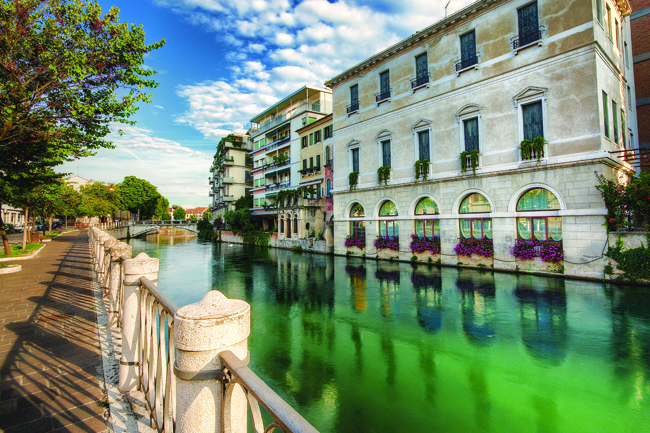
Treviso is a name familiar to the millions of travellers who arrive and depart the bel paese using the conveniently located airport in the heart of the Veneto region, yet unfortunately, few will recall the city with family and friends on their return home. Treviso is still predominately a stepping stone to the more established locations in the region such as Padova, Verona, Vicenza and the gem itself, Venice. Padova, with its world renowned university and lively nightlife, Verona, with its Roman amphitheatre and Juliet’s balcony, Vicenza, the City of Andrea Palladio, and Venice, the floating jewel of Italy, surely give substance for jumping straight onto the coach or train once stepping outside the airport…
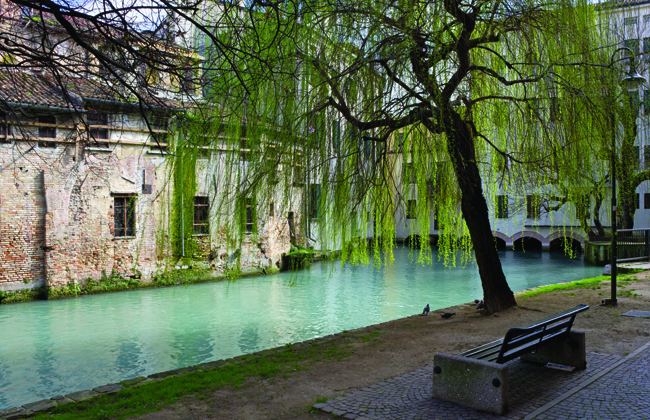
Well, in many ways they do. However, you will be one of thousands doing so and with that you will fall into the trap of merely being a sightseer, bagging a photograph at St Mark’s square, below Juliet’s balcony or in a gondola. Treviso offers something, certainly all year round, that the others will not: freedom, and a real sense of what it is to experience a major northern Italian city without hordes of tourists. It is a city that boasts its own beauty, charm and uniqueness. And of course, it is also the city that gave the world prosecco and tiramisù!
Treviso is extremely picturesque and still provides glimpses of its glorious history. The city is encircled by impressive 16th century walls and criss-crossed by small canals, where weeping willows appear almost to bow in homage to the beauty of the city. You will even find functioning water mills dotted along the canals and some art installations actually in the water.
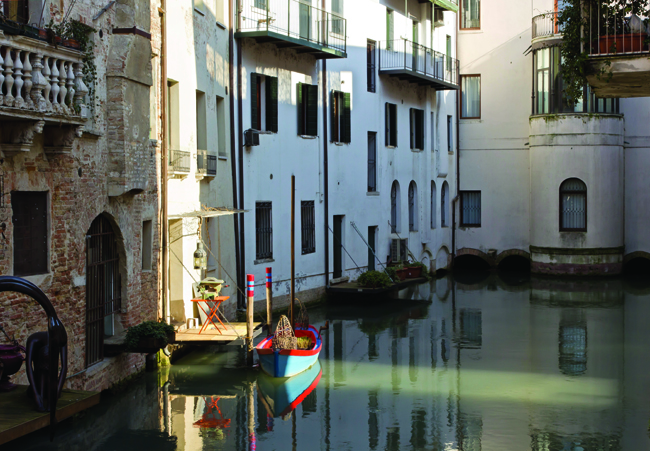
Like most medieval cities, the best way to experience it is definitely on foot – while strolling along the cobbled streets you can admire pretty Renaissance squares, long arcades, frescoed house façades and stunning palaces. The splendour of the frescoes on the façades of the buildings gave the town its other pretty nickname urbs picta – the painted city. Although they are faded now, some of these frescoes are still visible and if you close your eyes you can imagine their colourful former glory.
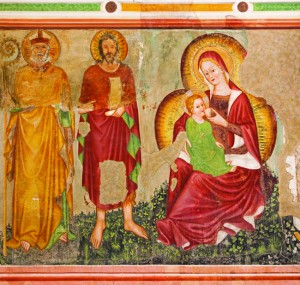
The centre is very easy to reach – a short walk from the railway will take you right at the heart of the city, Piazza dei Signori. Here, you will immediately notice the majestic Palazzo dei Trecento (capped with Guelph crenellations) which is the most significant example of Romanesque architecture in town, and the symbol of Treviso. The huge crack in the building’s façade is “a fake”, or better, just a reminder of where it was damaged by the American bombings in the Second World War.
On the north side of the square is the Palazzo del Podestà, dominated by the great tower (Torre del Comune). The square with its pretty cafés is the salotto di Treviso (Treviso’s “drawing room”) where all the locals tend to meet for a spritz and ciacole (gossip). In a courtyard tucked behind Piazza dei Signori, in the Galleria della Strada Romana, is a replica of the famous Fontana delle Tette (the original “Fountain of the Tits” is in the Palazzo dei Trecento). The statue is well known, as once, throughout all of the 16th century and up until the end of the Serenissima Republic (1797), it used to spill red and white wine from its breasts for three whole days after the election of each new mayor. This is where the Trevigiani (the residents of Treviso) could once drink wine for free while cheering the new Podestà and where nowadays young people take selfies holding its breasts.
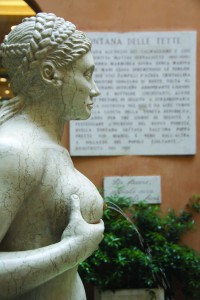
Just around the corner is Via Calmaggiore, the best spot for shopping. This elegant street offers great shops in a super classy setting. However, I am a true believer that for some serious shopping you need concentration, and in order to concentrate great food is needed… So for me the morning is reserved only for window shopping as my stomach is (as always!) the priority!
Walking in direction of Piazza San Vito with my family, we were looking at the different restaurants and osterie in search of inspiration… We decided to stop to have lunch at Cantinetta Venegazzù as we liked the friendly atmosphere and the great selection of wines. We ordered several starters to share and some typical local dishes. Our favourites, for sure, the porchetta (spit-roasted pork) and the radicchio rosso di Treviso (a variety of chicory typical of the area). Just before leaving we started chatting with some of the locals. Alberto, a Trevigiano DOC, was super friendly. He offered to take us with him on a short tour of the town. With his paisley shirt and his big smile, he is truly a character and everybody in town seems to know him.
Alberto started telling us about the place just in front of the restaurant where we had lunch. Here is where allegedly, tiramisù was invented. At the beginning of the ‘70s, the then owner of the restaurant Le Beccherie, with the help of her chef, invented the recipe of one of the most famous desserts ever. We then stopped for a quick macchiato just near the house of the founder of the Benetton Empire. Alberto was keen to show us his favourite restaurants and osterie and so this early afternoon turned quickly into an unconventionally early Prosecco crawl. Every stop at an osteria needed to be properly cherished by a kindly offered glass of Prosecco.
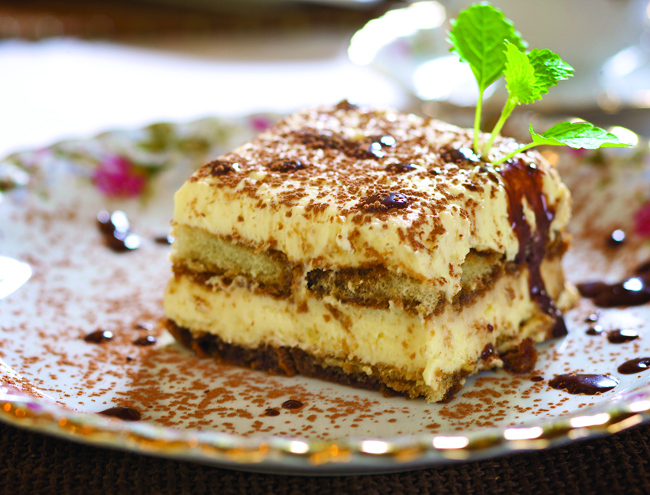
In one of the osterie I was told that in order to see Treviso properly one must see it as locals do… I am still wondering if the guy who told me this meant that this is possible only after a few drinks or only with the relaxed pace of life and a smile on the face which is typical of the Trevigiani… Perhaps both!
We walked towards the Buranelli, the most picturesque corner in Treviso. The canal takes its name from the storehouse once owned by fishermen coming from the island of Burano, in the Venetian lagoon. The calm waterway, almost touched by the weeping willow, the long arcades, and the work of art by Mario Martinelli – which covers the wall of the house where the writer Giovanni Comisso once lived – create a lovely view that is the subject of many paintings.
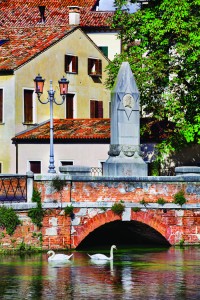 Finally, we headed towards the town’s walls and said goodbye to our wonderful guide. We then followed the green ring encircling the walls, looking at the swans and at some very cute ducklings hiding under their mum’s wings.
Finally, we headed towards the town’s walls and said goodbye to our wonderful guide. We then followed the green ring encircling the walls, looking at the swans and at some very cute ducklings hiding under their mum’s wings.
The following day – after a relaxing evening dining at Odeon alla Colonna – we hired bikes and cycled for miles along the river, completely surrounded by nature. The itinerary, taking us all the way to Casale del Sile, starts from the place where the burci once used to stop. The burci were big wooden boats dragged by horses and oxen that used to transport goods from Venice to Treviso. The itinerary follows the path that was used by the animals along the River Sile. Midway along the path is a very interesting view: the “Cemetery of the Burci”. This is the place where, in the ‘70s, all the boats were left to sink as a protest against the arrival of the road transport that stole their jobs. Today, this is a charming place when you can observe different species of birds and fish and just simply enjoy the beauty of nature.
Not only does Treviso offer a great historical centre, it also offers a perfect starting point to explore the panorama of the Marca Trevigiana (the area around Treviso). The place known as the original production area for Prosecco – the Prosecco Wine Route – is the most popular wine route in Italy. If you hire a car you will be able to discover the land between Conegliano and Valdobbiadene, which offers a patchwork of vineyards, stunning views with ancient castles, charming churches and noble villas. You can visit beautiful old villages and wineries where you will learn everything about the method of Prosecco making and you will test the superior quality of the world famous sparkling white wine.
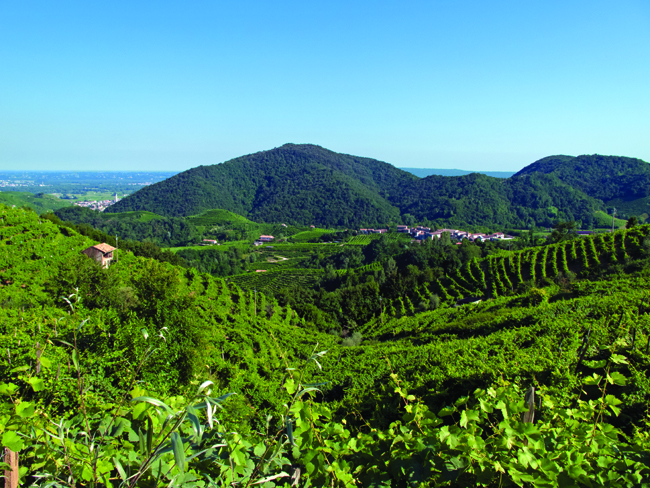
Read more from Sara Scarpa and her travels in our archive
